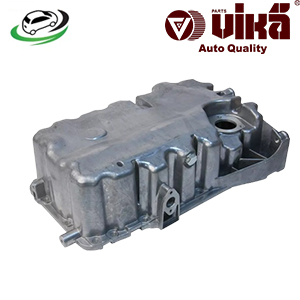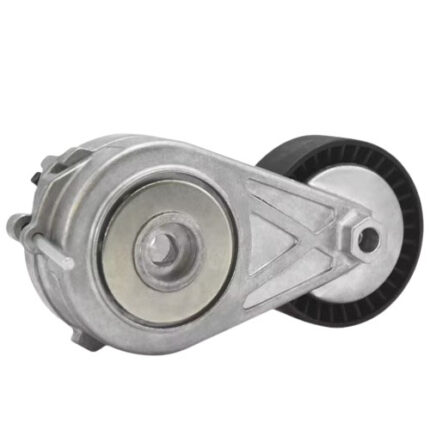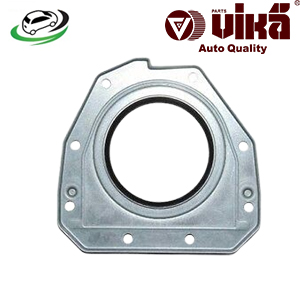-13%
Get Transmission Crankshaft Shaft Seal AUDI (8X1/8XK)/ A1 Sportback/ A3 (8P1)/ A4 B8 (8K2)/ A4 B9/ VW CC B7 (358)/ EOS (1F7/1F8)/ Golf V (1K1) 06H103171F
The transmission crankshaft seal, often referred to as the crankshaft rear seal or rear main seal, is a critical component of an engine’s sealing system. It sits at the rear of the engine, where the crankshaft exits the engine block and connects to the transmission. This seal plays a crucial role in maintaining engine performance and preventing various problems. Here’s an in-depth look at the transmission crankshaft seal, its functions, common issues, and the process for replacement.
Function of the Transmission Crankshaft Seal
- Prevents Oil Leaks
- Oil Containment: The primary function of the crankshaft seal is to prevent engine oil from leaking out of the rear of the engine. It seals the space between the crankshaft and the transmission, keeping the oil contained within the engine block and the crankcase.
- Maintains Oil Pressure: By preventing oil leaks, the seal helps maintain proper oil pressure within the engine. Adequate oil pressure is essential for lubricating and cooling engine components.
- Protects the Transmission
- Prevents Contamination: The seal also helps protect the transmission from contamination by keeping engine oil and debris from entering the transmission system. This is crucial for maintaining the longevity and performance of the transmission.
- Reduces Engine Emissions
- Minimizes Leaks: By ensuring a proper seal, the crankshaft seal helps prevent oil leaks that can lead to increased emissions. Leaks can contribute to environmental pollution and affect vehicle emissions performance.
- Supports Engine Efficiency
- Maintains Lubrication: A properly functioning seal ensures that engine oil remains where it is needed, supporting efficient lubrication of the crankshaft and other engine components. This helps in reducing friction and wear.
Common Issues with the Transmission Crankshaft Seal
- Oil Leaks
- Visual Signs: One of the most common issues with the crankshaft seal is oil leakage. Leaks can often be spotted as oil spots or puddles under the vehicle, especially near the rear of the engine.
- Engine Smoke: If oil leaks onto hot engine components, it can produce smoke and a burning oil smell, which indicates a problem with the seal.
- Cracked or Worn Seal
- Wear and Tear: Over time, the rubber or elastomer material of the seal can become brittle, cracked, or worn due to heat, age, or exposure to contaminants. This degradation can lead to leaks and reduced effectiveness.
- Environmental Factors: Exposure to extreme temperatures and engine vibrations can accelerate the wear and tear on the seal, causing it to fail prematurely.
- Improper Installation
- Misalignment Issues: If the crankshaft seal is not installed correctly, it can lead to misalignment, which may cause oil leaks or damage to the seal. Proper installation is crucial for ensuring a proper fit and function.
- Seal Damage: Installing the seal improperly can also cause damage to the seal itself or the crankshaft surface, leading to further leaks and potential engine damage.
- Crankshaft Damage
- Surface Issues: A damaged or worn crankshaft surface can affect the seal’s ability to maintain a proper seal. Grooves, scoring, or other damage to the crankshaft can lead to oil leaks and seal failure.
- Seal Wear: Damage to the crankshaft can cause uneven wear on the seal, leading to premature failure.
Symptoms of a Faulty Transmission Crankshaft Seal
- Engine Oil Leaks
- Visible Leaks: Leaking oil around the rear of the engine is a clear sign that the crankshaft seal may be faulty. Look for oil pooling or dripping beneath the vehicle or around the engine block.
- Oil Spots: Oil spots on the ground where the vehicle is parked can indicate a problem with the crankshaft seal.
- Burning Oil Smell
- Smoke: If oil from a leaking seal comes into contact with hot engine components, it can produce a burning smell and smoke, which is a strong indicator of seal failure.
- Low Oil Pressure
- Warning Light: A drop in oil pressure due to leaks from a faulty seal can trigger the oil pressure warning light on the dashboard. Low oil pressure can lead to engine damage if not addressed promptly.
- Engine Noise
- Unusual Sounds: A faulty seal may cause engine noise due to low oil levels or poor lubrication. Noise such as knocking or ticking can indicate that the crankshaft or other engine components are not properly lubricated.
- Transmission Issues
- Contamination Signs: If engine oil leaks into the transmission, it can cause shifting problems or transmission slippage. Contamination can affect the transmission’s performance and longevity.
Benefits of the Transmission Crankshaft Seal
1. Prevents Oil Leaks
- Seals Oil Containment: The primary benefit of the crankshaft seal is its ability to prevent engine oil from leaking out of the rear of the engine. This containment is essential for maintaining proper oil levels within the engine and preventing oil from escaping into areas where it can cause damage or mess.
- Protects the Environment: By preventing oil leaks, the seal helps avoid environmental contamination. Leaked oil can pollute the soil and waterways, making the seal’s role in maintaining environmental standards significant.
2. Maintains Engine Oil Pressure
- Ensures Proper Lubrication: The crankshaft seal helps maintain the engine’s oil pressure by keeping the oil contained within the engine block. Proper oil pressure is crucial for lubricating and cooling engine components, which helps reduce friction and wear.
- Prevents Engine Damage: By maintaining adequate oil pressure, the seal helps protect the engine from potential damage caused by insufficient lubrication, which can lead to severe engine wear or failure.
3. Protects the Transmission
- Prevents Contamination: The crankshaft seal prevents engine oil from entering the transmission. This protection is crucial because contamination by engine oil can lead to transmission performance issues and potential damage.
- Supports Transmission Longevity: By keeping the transmission free from engine oil contamination, the seal helps ensure the transmission operates smoothly and lasts longer.
4. Enhances Engine Efficiency
- Reduces Friction: Proper sealing helps reduce oil leaks and ensures that oil remains where it is needed. This efficient lubrication reduces friction within the engine, contributing to better fuel efficiency and overall engine performance.
- Supports Optimal Operation: A well-functioning crankshaft seal supports the engine’s ability to operate efficiently, helping to maintain fuel economy and power output.
5. Reduces Emissions
- Minimizes Oil Leaks: By preventing oil leaks, the seal helps reduce the likelihood of oil burning on hot engine parts, which can lead to increased emissions. Efficiently contained oil helps the engine operate within emission standards.
- Maintains Clean Engine Bay: A properly installed crankshaft seal prevents oil spills and drips in the engine bay, contributing to a cleaner and more environmentally friendly engine operation.
6. Prevents Engine Overheating
- Supports Cooling: By ensuring that oil remains where it should be, the seal helps in maintaining the proper flow of oil through the engine. This flow supports cooling by carrying heat away from critical engine components.
- Avoids Heat Build-Up: Proper sealing helps prevent oil from leaking onto hot engine components, which could otherwise contribute to heat build-up and potentially cause overheating.
7. Enhances Vehicle Resale Value
- Indicates Good Maintenance: A properly functioning crankshaft seal is indicative of good vehicle maintenance. Vehicles that are free from leaks and oil-related issues generally have higher resale values.
- Prevents Damage: By preventing leaks and maintaining engine and transmission health, the seal helps preserve the overall condition of the vehicle, making it more attractive to potential buyers.
8. Improves Engine Performance
- Consistent Oil Pressure: Maintaining proper oil pressure through effective sealing ensures that all engine components receive adequate lubrication, which supports consistent engine performance.
- Smooth Operation: A well-functioning crankshaft seal helps ensure smooth engine operation by preventing leaks that could lead to performance issues or rough running.
9. Supports Long-Term Durability
- Reduces Wear: By keeping the engine oil contained and preventing leaks, the crankshaft seal helps reduce wear and tear on both the engine and transmission components.
- Extends Component Life: Proper sealing extends the life of critical components by preventing issues related to oil leaks, contamination, and inadequate lubrication.
10. Facilitates Routine Maintenance
- Easier Inspections: A well-installed crankshaft seal helps keep the engine bay clean and free from oil leaks, making it easier to perform routine inspections and maintenance tasks.
- Minimizes Repairs: By preventing common issues associated with oil leaks, such as damage to engine components or the transmission, the seal helps reduce the frequency and cost of repairs.
Best Practices
- Use Quality Parts: Always use high-quality seals and components to ensure a proper fit and long-lasting performance. OEM parts or reputable aftermarket brands are recommended.
- Follow Manufacturer’s Instructions: Adhere to the manufacturer’s guidelines for installation and torque specifications to avoid damage and ensure a proper seal.
- Inspect Regularly: Regularly inspect the oil pan area for signs of leaks or damage to catch potential issues early.
Follow us on Facebook for more parts.



